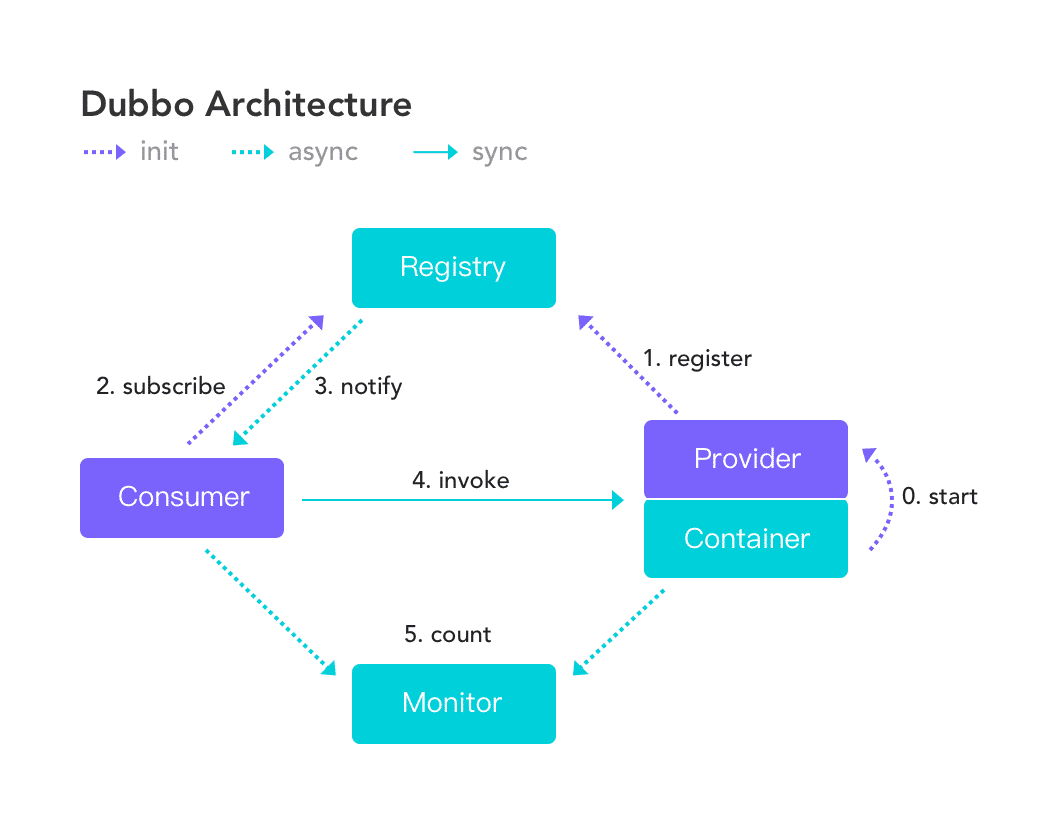简介
dubbo是一个高性能的rpc框架。它提供了三大核心能力:面向接口的远程方法调用,智能容错和负载均衡,以及服务自动注册和发现。

dubbo的流程:
初始化阶段:服务提供方注册服务(注册也就是将自己的信息写入注册中心,让别人能够找到自己,从而调用自己),服务消费方订阅服务
当服务消费方想要调用服务时,会区注册中心寻找服务的信息,然后通过网络连接服务提供方,远程调用方法,服务提供方调用方法后将结果返回给服务消费方。
监控中心可以监控整个提供服务提供方和消费方。
使用
dubbo使用很简单,了解的dubbo的启动需要哪些条件(注册中心,服务调用方,消费方,接口),那么使用也就简单了,只需要服务提供方暴露服务给注册中心,服务消费方远程调用服务即可。
不要忘记引入依赖,我这里使用的是:1
2
3
4
5
6
7
8
9
10
11<dependency>
<groupId>com.alibaba</groupId>
<artifactId>dubbo</artifactId>
<version>2.6.5</version>
</dependency>
<!--操作zookeeper的依赖-->
<dependency>
<groupId>org.apache.curator</groupId>
<artifactId>curator-framework</artifactId>
<version>2.12.0</version>
</dependency>
API配置
需求:消费方想要调用一个hello方法,调用服务提供方的方法,得到结果
1 | public interface Hello { |
服务提供方:1
2
3
4
5
6
7
8
9
10
11
12
13
14
15
16
17
18
19
20
21
22
23
24
25
26
27
28
29
30
31
32
33
34
35
36
37
38
39
40
41
42package provider;
public class Provider1 {
public static void main(String[] args) throws IOException {
//服务实现,可以提供服务的对象
Hello javaHello=new JavaHello();
//配置当前应用
ApplicationConfig applicationConfig=new ApplicationConfig();
applicationConfig.setName("hello-provider");
//连接注册中心,注册中心可以有多种,比如zookeeper,redis等等
RegistryConfig registryConfig =new RegistryConfig();
registryConfig.setAddress("zookeeper://127.0.0.1:2181");
registryConfig.setUsername("aaa");
registryConfig.setPassword("bbb");
//服务提供方协议配置,这里使用的是dubbo,具体的协议使用范围不同,可以参考官方文档
ProtocolConfig protocolConfig=new ProtocolConfig();
protocolConfig.setName("dubbo");
protocolConfig.setPort(22880);
protocolConfig.setThreads(10);
//暴露服务配置
// 注意:ServiceConfig为重对象,内部封装了与注册中心的连接,以及开启服务端口
ServiceConfig<Hello> serviceConfig=new ServiceConfig<Hello>();
serviceConfig.setApplication(applicationConfig);
serviceConfig.setRegistry(registryConfig);
serviceConfig.setProtocol(protocolConfig);
serviceConfig.setInterface(Hello.class);
serviceConfig.setRef(javaHello);
serviceConfig.setVersion("1.0.0");
//服务暴露及注册
serviceConfig.export();
System.in.read();
}
}
服务消费方1
2
3
4
5
6
7
8
9
10
11
12
13
14
15
16
17
18
19
20
21
22
23
24
25
26package consumer;
public class Consumer1 {
public static void main(String[] args) {
// 当前应用配置
ApplicationConfig application = new ApplicationConfig();
application.setName("hello-consumer");
// 连接注册中心配置
RegistryConfig registry = new RegistryConfig();
registry.setAddress("zookeeper://127.0.0.1:2181");
registry.setUsername("aaa");
registry.setPassword("bbb");
// 注意:ReferenceConfig为重对象,内部封装了与注册中心的连接,以及与服务提供方的连接
//引用远程服务
ReferenceConfig<Hello> referenceConfig =new ReferenceConfig<Hello>();
referenceConfig.setApplication(application);
referenceConfig.setRegistry(registry); // 多个注册中心可以用setRegistries()
referenceConfig.setInterface(Hello.class);
referenceConfig.setVersion("1.0.0");
Hello javaHello=referenceConfig.get();
System.out.println(javaHello.hello("zzx"));
}
}
观察结果发现服务提供发打印了一条消息,而服务消费方也打印了一条消息。
观察注册中心:1
2
3
4[zk: localhost:2181(CONNECTED) 6] ls /dubbo/api.interfaces.Hello
[consumers, configurators, routers, providers]
[zk: localhost:2181(CONNECTED) 7] ls /dubbo/api.interfaces.Hello/providers
[dubbo%3A%2F%2F172.17.0.1%3A22880%2Fapi.interfaces.Hello%3Fanyhost%3Dtrue%26application%3Dhello-provider%26dubbo%3D2.0.2%26generic%3Dfalse%26interface%3Dapi.interfaces.Hello%26methods%3Dhello%26pid%3D23265%26revision%3D1.0.0%26side%3Dprovider%26threads%3D10%26timestamp%3D1558959362483%26version%3D1.0.0]
可以看见在/dubbo/api.interfaces.Hello节点下有[consumers, configurators, routers, providers]这几个节点:消费订阅者,配置,路由,服务提供者
在/dubbo/api.interfaces.Hello/providers节点下,将节点内容进行url解码后是:1
dubbo://172.17.0.1:22880/api.interfaces.Hello?anyhost=true&application=hello-provider&dubbo=2.0.2&generic=false&interface=api.interfaces.Hello&methods=hello&pid=23265&revision=1.0.0&side=provider&threads=10×tamp=1558959362483&version=1.0.0
这里包含了,服务提供方的联系方式,提供的服务的接口等等各种信息。
显而易见,在consumers下也有会存储一些信息。
还有一些特殊的场景,比如方法级设置,点对点直连等等。
当然它的功能不仅仅这么简单,但是一般不这么使用,而是与Spring集成。
与Spring集成
服务提供方1
2
3
4
5
6
7
8
9
10
11
12
13
14
15
16
17
<beans xmlns:xsi="http://www.w3.org/2001/XMLSchema-instance"
xmlns:dubbo="http://dubbo.apache.org/schema/dubbo"
xmlns="http://www.springframework.org/schema/beans" xmlns:context="http://www.springframework.org/schema/context"
xsi:schemaLocation="http://www.springframework.org/schema/beans http://www.springframework.org/schema/beans/spring-beans.xsd
http://dubbo.apache.org/schema/dubbo http://dubbo.apache.org/schema/dubbo/dubbo.xsd http://www.springframework.org/schema/context http://www.springframework.org/schema/context/spring-context.xsd">
<!--<dubbo:application name="demo-consumer"/>
<dubbo:registry group="aaa" address="zookeeper://127.0.0.1:2181"/>
<dubbo:reference id="demoService" check="false" interface="org.apache.dubbo.samples.basic.api.DemoService"/>
-->
<context:component-scan base-package="impl"/>
<dubbo:application name="consumer_1"/>
<dubbo:registry address="zookeeper://127.0.0.1:2181"/>
<dubbo:protocol name="dubbo" port="20890"/>
<dubbo:reference interface="com.zzx.service.UserService" id="userService"/>
</beans>
注解配置
dubbo也可是使用注解配置,需要配置的信息与上面一致,只是实现方式不同而已。
可以很清楚的看见也就是将上面的ConfigXXX的内容写在的xml标签中,而事实上在配置在xml中,在解析xml后,dubbo也会将创建ConfigXXX对象,写入配置信息。只不过写在配置文件中更加便捷,易于修改。
原理浅析
1 | Hello javaHello=referenceConfig.get(); |
从上面可以看见实际上调用的核心是这一段代码,那么它的具体流程是怎样的?
- javaHello不是“纯粹”的Hello对象,而是一个代理对象
- 在代理对象中拦截的这个方法
- 在拦截方法后,将这些接口,方法,参数,服务消费方的一些信息封装成了一条消息,将这些消息发送个从注册中心知道的服务提供方的地址
- 服务提供放收到消息后,根据接口,方法,参数等信息,生成一个代理对象,执行方法
- 服务提供方将执行后的结果封装成一条信息,发送给服务消费方,服务消费方得到结果,返回
当然,dubbo的设计远不止这么简单,具有很多层次,很多功能。这里只是简单说明原理。
